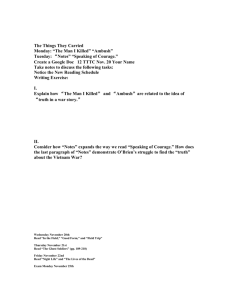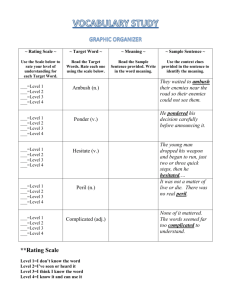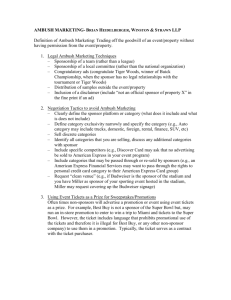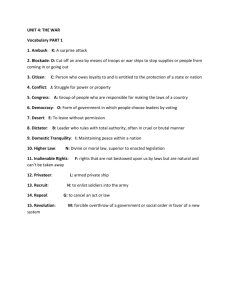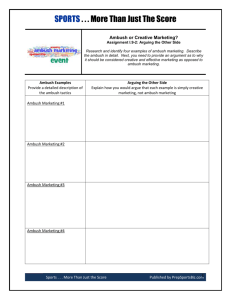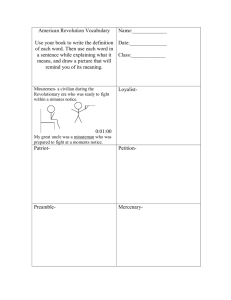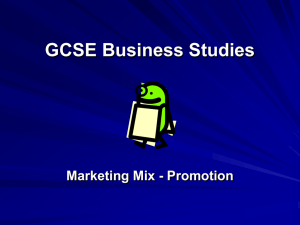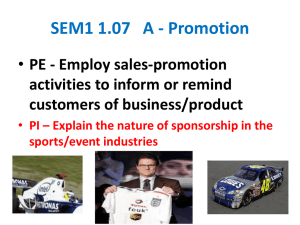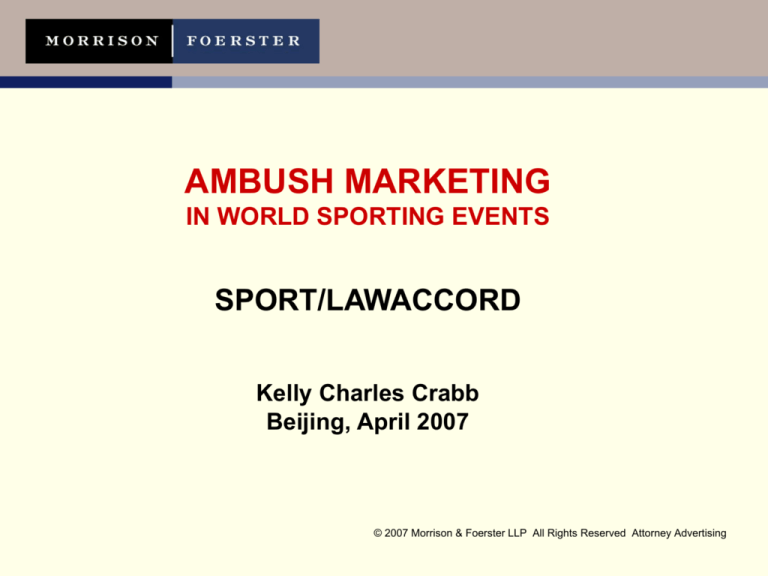
AMBUSH MARKETING
IN WORLD SPORTING EVENTS
SPORT/LAWACCORD
Kelly Charles Crabb
Beijing, April 2007
© 2007 Morrison & Foerster LLP All Rights Reserved Attorney Advertising
OVERVIEW
Development of Commercial Sponsorships
Sponsorship Goals and Rights
The Olympic Games as a Sponsorship Model
Ambush Marketing
Ambush Strategies
Effects of Ambush Marketing (Three
Perspectives)
Countermeasures to Ambush Marketing
DEVELOPMENT OF
COMMERCIAL SPONSORSHIPS
The First Modern Olympic Games (1896)
67% of cost by private donations
22% from the sale of special stamps
11% from tickets (60,000), coins, medals
DEVELOPMENT OF
COMMERCIAL SPONSORSHIPS
Olympic Games since 1984
Seoul 1988: $338 million in sponsorship fees
Atlanta: World and Games sponsors put in over $1 billion
for sponsorship rights (33 sponsors averaging over $40
million each)
Sydney attracted $700 million in local sponsorship revenue
alone
Salt Lake City made $850 million from all sources
DEVELOPMENT OF
COMMERCIAL SPONSORSHIPS
The “five rings” -- introduced in 1914 -- is the
most recognized trademark in the world
DEVELOPMENT OF
COMMERCIAL SPONSORSHIPS
Other World Sports Organizations
World Cup Soccer
Formula One Racing
National Hockey League
Special Olympics
National Football League
Major League Baseball
National Basketball Association
SPONSORSHIP GOALS & RIGHTS
Benefits of Association
Access to the audience
Link to event values
Survey (2000): Over 80% associated the five rings
with “success” and “high standards” and 60%
with “world peace”
SPONSORSHIP GOALS & RIGHTS
Link to values:
SPONSORSHIP GOALS & RIGHTS
Rights
Category exclusivity
“Exclusive,
legal access to the public profile and positive
values associated with the Olympic Games” – Michael
Payne, IOC Director of Marketing
World Cup 1994: MasterCard vs.. Sprint
MasterCard: “card-based payment and account
devices”
Sprint: “long distance telecommunications” Sprint
made pre-paid telephone cards – the courts sided with
MasterCard
SPONSORSHIP GOALS & RIGHTS
Rights
Right to use official marks and
designations
SPONSORSHIP GOALS & RIGHTS
Rights
Right of hospitality
Access to the Games
Accommodations
Hospitality suites
Tickets
THE OLYMPIC GAMES
AS A SPONSORSHIP MODEL
International Olympic Committee (IOC) as Owner
“The Olympic Partner” (TOP) Program
Exclusive use of five rings standing alone
Worldwide territory
Highest level of hospitality and other rights
THE OLYMPIC GAMES
AS A SPONSORSHIP MODEL
National Olympic Committee
Marketing rights (shared with OCOG)
Salt Lake 2002: Joint Venture with SLOC
Beijing 2008: BOCOG controls
Team sponsorships
THE OLYMPIC GAMES
AS A SPONSORSHIP MODEL
Organizing Committee for the Olympic Games (OCOG)
Sponsors of the Games (Host Country Only):
THE OLYMPIC GAMES
AS A SPONSORSHIP MODEL
Organizing Committee for the Olympic Games (OCOG)
Highest level of Games sponsors (Partner)
Category exclusivity
Greatest level of benefits
Use of official OCOG Marks
Access, hospitality, tickets
Highest domestic price
Can’t be greater than TOP
THE OLYMPIC GAMES
AS A SPONSORSHIP MODEL
Organizing Committee for the Olympic Games
(OCOG)
Mid-level sponsors (Sponsor)
Category exclusivity
Limited designation rights
Limited access, hospitality, tickets
Mid-level domestic price
THE OLYMPIC GAMES
AS A SPONSORSHIP MODEL
Organizing Committee for the Olympic Games
(OCOG)
Official suppliers (Supplier)
Exclusive/non-exclusive
Less of everything
VIK, not cash
Licensees (merchandise)
Right to exploit Games (OCOG) marks in
merchandise
AMBUSH MARKETING
Unauthorized association with sporting event
or movement
No compensation paid to event owner or the
organizer
Public misconception of official association
AMBUSH MARKETING STRATEGIES
Sponsorship of media coverage of the event
Los Angeles 1984: Fuji was worldwide sponsor
in film category, Kodak became a sponsor of the
television broadcast by CBS
Lillehammer 1994: McDonalds was the food
sponsor, but Wendy’s bought ad time during the
Games (ads were “spoofs” on the games)
AMBUSH MARKETING STRATEGIES
Sponsor subcategory within the
event and exploit aggressively
Los Angeles 1984: When Fuji Film became the worldwide film
sponsor, Kodak because the “official film” of the US Track and Field
Team
Seoul 1988: Roles reversed: Kodak was the worldwide film
sponsor and Fuji became the sponsor of the US Swim Team
AMBUSH MARKETING STRATEGIES
Sponsor subcategory within the
event and exploit aggressively
World Cup 1990: Coke was the worldwide
soft drink sponsor, Pepsi was the sponsor
of the Brazilian Team
AMBUSH MARKETING STRATEGIES
Sponsor subcategory within the
event and exploit aggressively
Sydney 2000: Qantas sponsored pre-Olympic meets and the
Olympic selection trials for the Australian Swim Team – the
trials were broadcast from the official Olympic venue where
Qantas put its name and logo
AMBUSH MARKETING STRATEGIES
Use current or former event winners or participants
in advertising
Calgary 1988: American Express, a sponsor of the 1984
Games, turned down a chance to be a sponsor of the
1988 Games, but used Billy Kidd and Eric Heiden (two
famous US Olympic Team athletes) in its ads
Atlanta 1996: Fuji put up billboards across the US
showing US Olympian Daniel O’Brian throwing a
Javelin – the USOC complained
Nagano 1998: Campbell Soup used three US figure
skaters in a series of ads – the USOC complained and
Campbell paid a “contribution” to the USOC
AMBUSH MARKETING STRATEGIES
Use current or former event winners or
participants in advertising
Sydney 2000: Qantas, not a sponsor,
used Olympians Cathy Freeman and
Kieren Perkins in ads
AMBUSH MARKETING STRATEGIES
Use current or former event winners or
participants in advertising
Sydney 2000: Adidas sponsored Ian Thorpe
(Australian Olympian), while Nike was the official
clothing supplier to the Australian Team – Thorpe
covered the Nike logo on the medals stand
AMBUSH MARKETING STRATEGIES
Make sponsorship contributions
to “cause” of event
Seoul 1988: Seagrams, a non sponsor, launched
a program called “Send the Families” – by paying
the cost of sending 500 relatives of the Canadian
team to the Seoul Games
AMBUSH MARKETING STRATEGIES
Make sponsorship contributions
to “cause” of event
Nagano 1998: Visa created picture menus so
foreign guests could order at Japanese
restaurants – the restaurant owners created large
signs advertising their participation in the “official
Olympic program”
This Restaurant
participates in the
Olympic Picture
Menu program
AMBUSH MARKETING STRATEGIES
Plan advertising that coincides with the event
Contests
Stanley Cup 1990: Coke became the official National
Hockey League (NHL) sponsor under license with
National Hockey League Services (NHLS), but Pepsi
sponsored the “Pro Hockey Playoff Pool” contest
hosted by a famous former player – the Canadian court
ruled for Pepsi in the famous case of NHL vs. PepsiCola Canada Ltd.
AMBUSH MARKETING STRATEGIES
Plan advertising that coincides
with the event
Activities within the geographical area
Los Angeles 1984: Converse was the official shoe sponsor
of the Games, Nike erected huge murals near the Los
Angeles Coliseum showing Nike track and field athletes
Atlanta 1996: A non-sponsor leased the outside of a tall
office building in plain view of the main track & field venue
and placed a banner -- covering a full side -- of the building
AMBUSH MARKETING STRATEGIES
Plan advertising that coincides
with the event
Activities within the geographical area
World Cup 1994: Adidas was the official
sponsor, but Puma hired a plane to fly over the
official venue trailing an advertising banner
AMBUSH MARKETING STRATEGIES
Plan advertising that coincides
with the event
Activities within the geographical area
Formula One, Australian Grand Prix 1999: In
the background, during the award of the
trophy, Messages on Hold Australia (MOHA)
waved a giant banner
AMBUSH MARKETING STRATEGIES
Plan advertising that coincides
with the event
Activities within the geographical area
Salt Lake 2002: Local owners of Burger King, a non
sponsor, launch a Games related campaign -- McDonalds is
the official sponsor
AMBUSH MARKETING STRATEGIES
Use generic words
Lillehammer 1994: Visa vs. American
Express – Visa, the official sponsor,
“American Express cards not accepted,” but
American Express, non sponsor, “you don’t
need a visa to go to Norway” (double
entendre)
AMBUSH MARKETING STRATEGIES
Use generic words
Sydney 2000: Landrover’s ad – “Let the
Games Begin!”
LET THE GAMES BEGIN!
AMBUSH MARKETING STRATEGIES
Use generic words
New Zealand Fair Olympic Association sued
Telecom New Zealand under the New Zealand Fair
Trading Act, but the court refused to grant an
injunction
RING RING RING
RING RING
AMBUSH MARKETING STRATEGIES
Apparel
Salt Lake City 2002: Columbia Sportswear
is not a sponsor, but NBC announcers
wore Columbia-branded apparel
AMBUSH MARKETING STRATEGIES
Apparel
Nagano 1998 & Salt Lake City 2002: Nike
was not an official sponsor or supplier, but
athletes wore Nike branded apparel and
used Nike-branded equipment
AMBUSH MARKETING STRATEGIES
Apparel
2006 FIFA World Cup: spectators wearing orange
Bavaria Brewery-branded Leeuwenhosen (overalls)
were ordered to disrobe by officials in Stuttgart, and
many of these Dutch supporters watched the game in
their underpants. (Budweiser was the official sponsor
of the World Cup.)
EFFECTS OF AMBUSH MARKETING
(THREE PERSPECTIVES)
Owner/Organizer
Official Sponsor
Competitor
EFFECTS OF AMBUSH MARKETING
(THREE PERSPECTIVES)
Owner’s and Organizer’s Viewpoint
Diminishes the value of the “official”
designation
Harm the financial viability of the event
Illegal, if marks are used
Costly to police
EFFECTS OF AMBUSH MARKETING
(THREE PERSPECTIVES)
Official Sponsor’s Viewpoint
Undermines the value of the investment
World Cup 2002: After the 1988 World Cup, Adidas
announced that it would not remain a sponsor unless
FIFA could assure that Adidas sponsorship
investment would be protected
EFFECTS OF AMBUSH MARKETING
(THREE PERSPECTIVES)
Official Sponsor’s Viewpoint
Unfair, as the competitor did not pay
Lillehammer 1994: IOC named Wendy’s the “worse
poacher” of the Games and criticized Wendy’s for not
supporting any athlete – “we want to expose them”
EFFECTS OF AMBUSH MARKETING
(THREE PERSPECTIVES)
Competitor’s Viewpoint
Competitor has no obligation to stand still (in fact,
it has an affirmative obligation to enhance
shareholder value by aggressive advertising)
“Marketing is a form of warfare, and the ambush is a
weapon!”
“Ambush marketing, correctly understood and rightly
practiced, is an important, ethically correct,
competitive tool in a non-sponsoring company’s
arsenal of business and image-building weapons.”
Jerry Welsh
EFFECTS OF AMBUSH MARKETING
(THREE PERSPECTIVES)
Competitor’s Viewpoint
Not illegal if trademarks are not used
EFFECTS OF AMBUSH MARKETING
(THREE PERSPECTIVES)
Competitor’s Viewpoint
Not illegal if disclaimers are used
Sydney 2000: Qantas’ poster
said “Sydney 2000*” — the
asterisk drew readers to a
small print disclaimer: “Qantas
is not an Olympic Sponsor”
COUNTERMEASURES TO
AMBUSH MARKETING
IOC requires host nation to
enact protective laws
Australia enacted the Sydney 2000 Games (indicia and
images) Protection Act of 1996
In 2002 Beijing Municipal Government promulgated
Regulations of Beijing Municipality on Protection of
Olympic Property
On January 30, 2002 - Executive Committee of the State
Council promulgated Decree No. 345 (Regulations on
Protection of the Olympic Symbols); on April 1, 2002 Decree No. 345 became effective as law in the Peoples
Republic of China
COUNTERMEASURES TO
AMBUSH MARKETING
IOC requires host nation to
enact protective laws
Canada made certain covenants in its application to host
the 2010 Games that Canadian law could be used to protect
against certain ambush marketing activities. New
legislation is currently being introduced in Canada which
would further restrict ambush marketing.
COUNTERMEASURES TO
AMBUSH MARKETING
IOC requires host to establish
ambush marketing plan
Monitor all venues
Coordinate with police authorities
Take action, when appropriate
COUNTERMEASURES TO
AMBUSH MARKETING
Official sponsors get first option
to sponsor broadcast of event
World Cup 1992: All advertising surrounding the
event was sold to official sponsors
IOC offers official sponsor is given first option to
acquire broadcast and advertising rights for the
event in each territory where broadcast rights are
sold – IOC/Broadcaster agreements
COUNTERMEASURES TO
AMBUSH MARKETING
IOC requires OCOG to
purchase all billboard space
surrounding and leading up
to the Games
COUNTERMEASURES TO
AMBUSH MARKETING
NOC can exercise leverage over athletes
Atlanta 1996: When Fuji Film used the image
of Daniel O’Brian, the USOC threatened to
disqualify O’Brian from the Games – Fuji
backed down and removed the billboards
COUNTERMEASURES TO
AMBUSH MARKETING
IOC imposes “clean venue” rules
IOC determines the size and location of logos
used on apparel worn by athletes and venue
officials
With minor exceptions, no advertising of any
kind is allowed at Olympic venues
o No display of logos on equipment (except timing
equipment)
o No signage
COUNTERMEASURES TO
AMBUSH MARKETING
Legal action taken
Salt Lake 2002: OCOG engaged in strategic filing of
law suits against sellers of counterfeit Olympic
merchandise (US trademark law) (all cases settled)
New Zealand NOC: Sued ambush marketer under
unfair trade practices law (lost)
COUNTERMEASURES TO
AMBUSH MARKETING
Threaten Negative Publicity
Seoul 1988: A credit card company gave away
medals from the non-existent Olympic Heritage
Committee – the IOC threatened to expose the
company, which ceased its activities immediately
Barcelona 1992: IOC exposed American Express
for its “themed” advertising campaign – even
though Olympic marks were not used
COUNTERMEASURES TO
AMBUSH MARKETING
Actions of official sponsors
Pressure IOC and OCOG to police rights
Pursue aggressive exploitation of rights
(don’t sit back)
Legal recourse against owner or organizer
SUMMARY
Companies derive substantial benefit from event
sponsorship marketing
Non-sponsors can try to take advantage of association
by various methods of “ambush marketing”
Laws prevent non-sponsors from using official marks
or emblems or purposefully misleading the public by
misrepresentations about association
Unfair trade practice law has not acted as a significant
restraint on ambush marketing
Owners and organizers (especially in the Olympic
Movement), however, have been successful in
establishing operating rules and procedures that
curtail ambush marketing
THE END
KELLY CHARLES CRABB
Morrison & Foerster LLP
555 W. Fifth Street, Suite 3500
Los Angeles, California 90013
213-892-5412
Kcrabb@mofo.com

